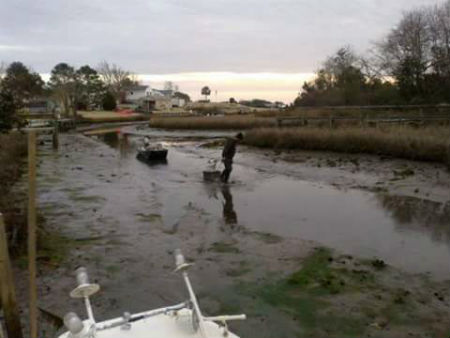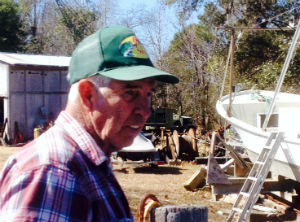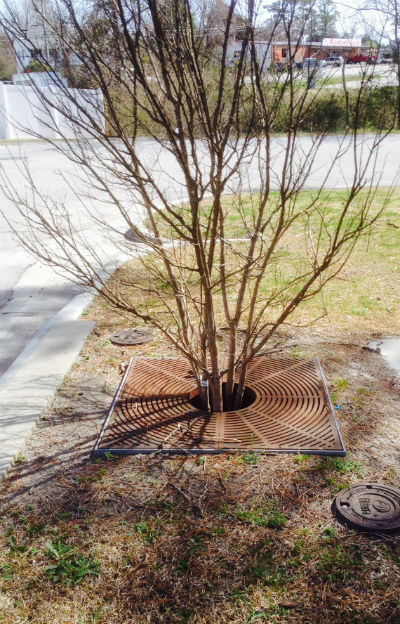First of two parts

SWANSBORO– When he was a young boy living in a house on Shore Drive in Swansboro close to 40 years ago, Eddie Privett and his buddies passed many a carefree summer day swimming in Hawkins Creek.
Supporter Spotlight
These days, there’s barely enough water to get your feet wet, and it’s often pretty nasty. One day early this month, it was so shallow that Privett, a commercial fisherman, had to anchor his boat and walk his five bushels of oysters – caught elsewhere, since polluted Hawkins has long been closed to shellfishing – to the dock.
Doris Shelton lives near Privett in a small house on Shore Drive that her late husband moved to in the 1960s. She has watched the creek change and recalls when it was plenty deep enough for watermen to bring their big boats in to shelter from approaching hurricanes. Her son-in-law keeps his boat at her house, but often can’t get out. And her son, who lives and keeps his boat in the nearby Broad Creek community in Carteret County, can rarely get in.
Shelton has noticed, too, that the creek – considered a primary nursery area for fish and shrump– has slowly but surely become less productive. She rarely sees fish and shrimp, and says the birds have noticed, too.
“We used to have those big white birds – egrets, I think – all over in the summer,” she said. “Now you might see one or two during the summer. I don’t think there’s really anything left for them to eat.”
Alex Moore has lived for more than 40 years close to the mouth of the creek on Hawkins Creek Lane. On a good day, he said, there might be a foot or two of water in the creek behind his house. At low tide on a bad day, there might be as little as a few inches. “It’s just a shame” he said, that for most people, Hawkins Creek isn’t good for much of anything except a pretty view.
Supporter Spotlight
Moore can still get his boat out to the Intracoastal Waterway nearby because he built a dredge in 1976 and cut a channel and still has a permit to keep it clear enough for a small boat . Few of his neighbors, though, can get their boats out without great difficulty.
It certainly hasn’t always been that way. He recalls his grandfather, who was born in 1906, telling him that at low tide in the old days there was as much as 4-1/2 feet of water. Now, in some places, you can walk long distances over mud flats, assuming you don’t first sink to your knees.
Moore, 71, is, like Privett, a Swansboro native. He made his living on the water as a ferry boat captain and a commercial fisherman before his recent retirement. He knows the water well, and he knows equally well that the story of Hawkins is a sad one.
But he also knows that it’s a pretty common tale, one that has befallen countless creeks in countless urban and suburban areas of coastal North Carolina. It’s a story of development, of course, but also of well-meaning rules and of equally well-meaning but ultimately futile efforts to fix these once-treasured thin blue map lines that once provided food, recreation and a way of life.
The Hawkins Story

Hawkins Creek’s particular story had been bubbling under the surface, surely unnoticed to almost anyone except those who live there, until recently, when an accidental discharge of water, sand and clay from a stormwater pond brought it into the light again.
This latest chapter of the winding saga started on Jan. 9, when Privett noticed that the water in the creek had risen suddenly, was a different color and was chock full of sediment. He and Tim Simpson, a friend who operates a tour boat from downtown Swansboro, traced the source of the dirt and water back to a pond behind the Hampton Inn and near Swansboro United Methodist Church, where an addition was being built. Both are off N.C. 24, the main road through town.
It turned out that John Freshwater was working on the pond, which catches runoff from the church construction site and from Ward Farm, a mixed residential and commercial development that Freshwater is planning behind the hotel. The state said he had to lower the water level to install a skimmer, which is intended to remove sediment from runoff. The plan went wrong.
The state stopped the pumping after about six hours. Freshwater said he would have stopped it sooner had he known that the water and sediment were getting into the marsh that borders the development and running into the creek. But he caught hell for it. That’s a bit ironic because Freshwater lives on the creek and has long advocated for ways to improve its quality.
Freshwater and his engineer, David Newsom, said they’ve spent a lot of money on fixes, but they’re hoping that the bad publicity will shed new light on the plight of the creek and will lead to something positive.
“If something good comes out of all this, then it will be OK,” Newsom said.
The state Division of Water Resources has taken an interest and has twice sent folks to take samples, not just of the water, but of the sediments at the bottom of the creek. While they’ve revealed a lot of material from the stormwater pond pumping incident, those samples also found a lot of sand. And not all that sand came come from the pond discharge.

Subsequent state studies found that Hawkins lacked the diversity of aquatic insects normally found in healthy coastal creeks. Insects that live in polluted water dominated. A state sediment study completed this month notes that the scoured banks of the upper portion of Hawkins is typical of urbanized streams subjected to flash flooding. State scientists found a deep accumulation of inorganic sand up to 700 yards downstream from N.C. 24.
“The apparent stratification and volume of the sand in the stream bed is indicative of long-term deposition from multiple sources, most likely related to stormwater drainage over a period of time,” the study concludes.
Though the study couldn’t determine the sources of the runoff, most people involve point to the state Department of Transportation, to Mother Nature, to the town and to construction of those very same Shore Drive homes that look over the creek.
Moore pointed mostly to that home construction, 50 or more years ago, noting that countless quantities of sand and dirt were used to build up the lots. “No one cared much about runoff then,” he recalls. “A lot went in.”
Shelton said she recalls Privett’s grandmother, who also lived on Shore Drive, describing standing on her back steps to hang laundry to dry. That’s how narrow the backyards used to be. But the residents filled in the wetlands and some of the creek to create what are now normal-sized yards, significantly narrowing the creek in the process.
No one thought a thing about it.
But Hawkins’ problems almost surely go back farther than that, to the extension of N.C. 24 into Swansboro in 1930, which altered the creek’s natural flow and the flow of stormwater runoff over the land. That was exacerbated when the road was widened in the mid-1970s to accommodate a booming tourist trade in neighboring Carteret County and to handle the traffic to and from growing Camp Lejeune, the Marine Corps base to the west in Jacksonville.
The land in the creek’s headwater was further altered in the late 1990s by the construction of a shopping center that legally filled in wetlands.
Failed Fixes
Hawkins Creek, which drains about 200 acres in the center of Swansboro, starts on the north side of N.C. 24 about where the Post Office is. It flows through a culvert under the road. That culvert has been one of the problems. Twice the road over it has washed out, sending more dirt and sand into the creek. The most recent washout, in late September 2010, followed a record-breaking 21 inches of rain that fell over several days and completely overwhelmed the DOT drainage system.
Topography certainly played a role, according to Newsom and Freshwater, who noted that the flood-prone section of N.C. 24 is at the bottom of a gently sloping V. All the water on either side flows downhill to that point.

When it repaired the 2010 washout, DOT improved the drainage, Newsom said. The town also did some work, putting in a filters on Shore Drive in December 2010 and installing a catch basin and a rock dam in the creek on the south side of the highway in order to stop sediment. Maintenance on them, though, has been spotty at best, and the filter basins now appear clogged and the rock dam isn’t working as it should.
Evidence of the problem was clear on the evening of March 14. After a day of light and occasionally moderate rain, water was flowing straight over the clogged filters and drains and overwhelming the catch basin where the dam is located, Privett said. As a result, plenty of sand from the highway went straight over the dam and into the creek.
“It was a lot of water and it wasn’t even that much rain,” Privett said that evening.
The town had tried to do something on a larger scale, too, prodded by Freshwater, an engineer, and others. It hired Rivers and Associates of Greenville to do a study, which outlined the creek’s problems. Swansboro then installed filters and catch basins at various places in the watershed.
Despite all that, stormwater runoff enters the creek through dozens of outlets, pipes and ditches, Freshwater said. “There are a lot of factors, a lot of issues, a lot of responsibility to go around,” he said.
Freshwater realizes he caught harsh criticism for the Jan. 9 pumping and knows that some people might think his main interest in the creek is related to his development project. He said he doesn’t think of himself as a developer. He wants to do right by the creek, he said.
The long-term fix, Freshwater added, won’t be simple.
“We all want good roads, we all want houses to live in, places to buy the things we need. We fertilize our lawns,” he said. “I don’t think any of these things (that have contributed to Hawkins’ troubles) were based on ill-intent.”
He pointed out that he lives on the creek, too, and loves it, and is saddened by its demise, as is his mother, who also lives there. As for his development, he said he’s always wanted to do it the right way, and wants to do something good for the town and its residents. “There will always be naysayers,” he said. “But I want to do something good. And I have always cared about Hawkins Creek.”
Privett agrees that Freshwater has always supported efforts to clean up the creek, but said the accident at the retention pond worsened the creek’s problems by pushing more sand farther along the stream.
A Jan. 12 inspection report from Karl Hammers, of the state Division of Energy, Mineral and Land Resources, cited Freshwater’s Ward Farm LLC for failing to meet most of the conditions of its permit. The state, though, took no enforcement action because it said Freshwater worked quickly to resolve the problems.
Shelton, whose husband was head of law enforcement for the N.C. Division of Marine Fisheries, knows the Freshwater family well and recalls one of Freshwater’s efforts.
“At one point I got a letter from a lawyer in Wilmington trying to get people interested in dredging the creek, asking us to send in a card. I did, although I knew I couldn’t afford to pay anything. I’m on a fixed income. But then I got another letter later that said it fell through. It would be nice if it could get done.”
Wednesday: What will it take to fix the creek?








